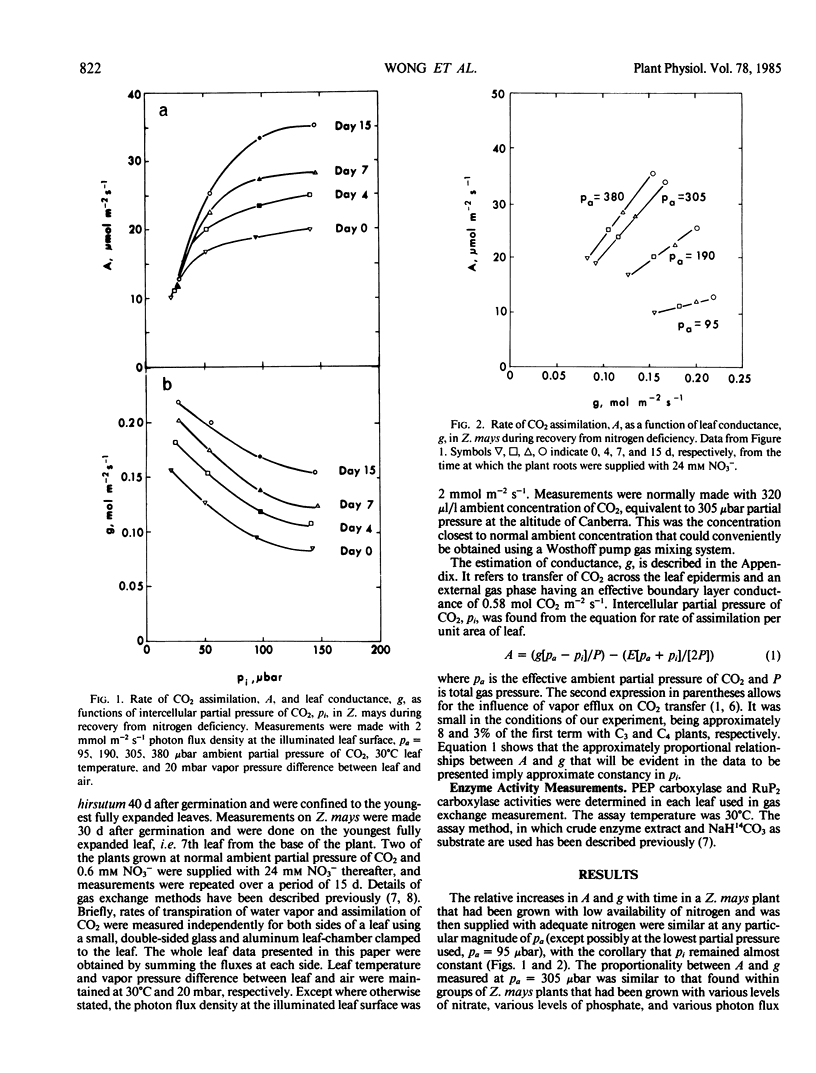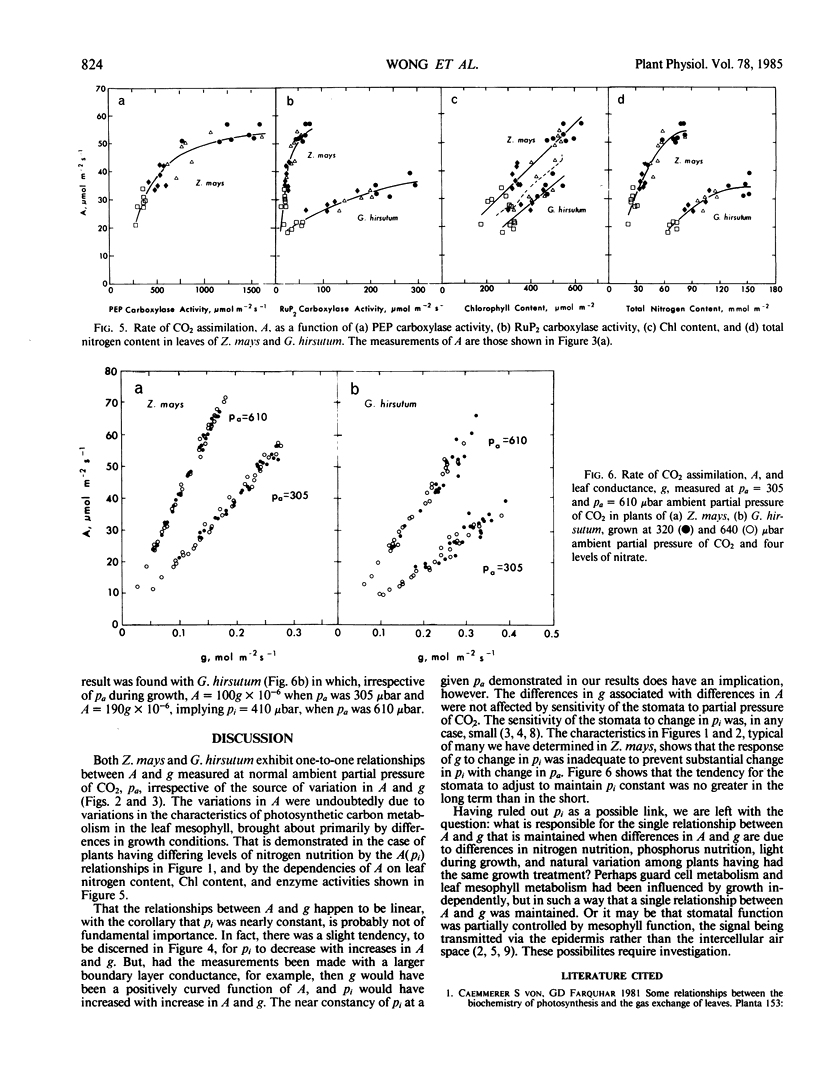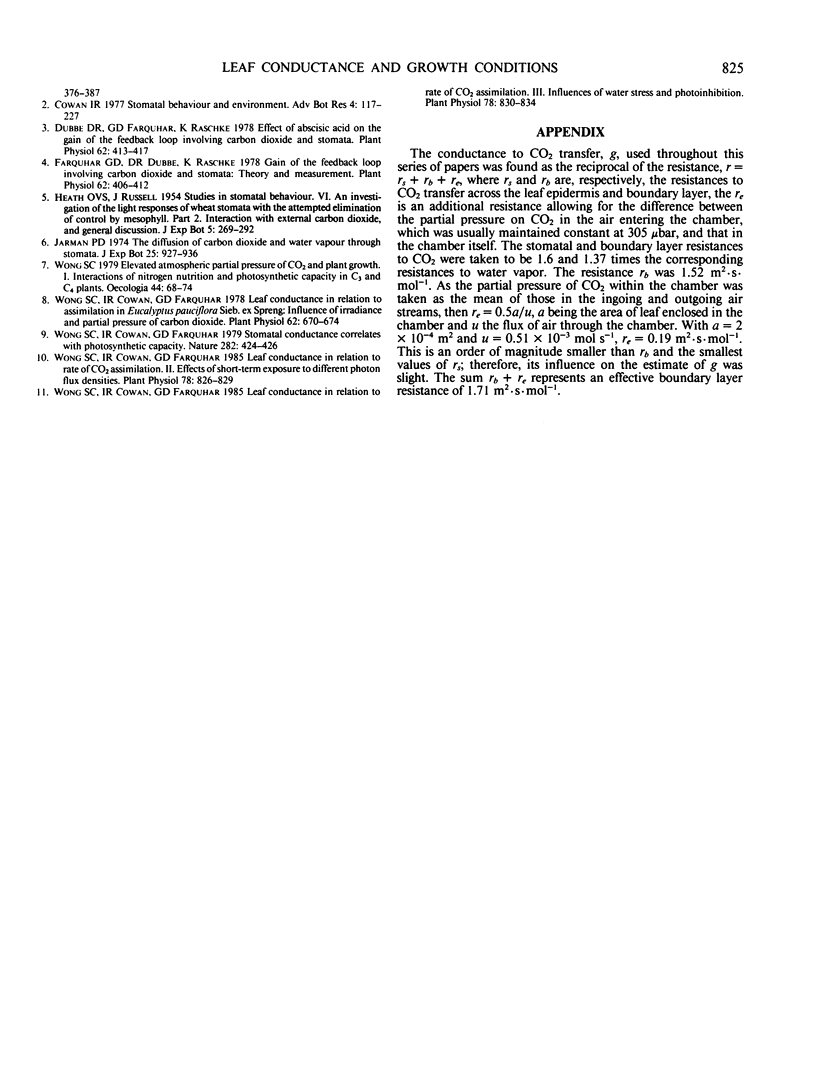Abstract
Plants of Zea mays were grown with different concentrations of nitrate (0.6, 4, 12, and 24 millimolar) and phosphate (0.04, 0.13, 0.53, and 1.33 millimolar) supplied to the roots, photon flux densities (0.12, 0.5, and 2 millimoles per square meter per second), and ambient partial pressures of CO2 (305 and 610 microbars). Differences in mineral nutrition and irradiance led to a large variation in rate of CO2 assimilation per unit leaf area (A, 11 to 58 micromoles per square meter per second) when measured under standard conditions. The variation was shown, with the plants that had received different amounts of nitrate, to be related to variations in the nitrogen and chlorophyll contents, and phosphoenolpyruvate and ribulose-1,5-bisphosphate carboxylase activities per unit leaf area. Irrespective of growth treatment, A and leaf conductance to CO2 transfer (g), measured under standard conditions were in almost constant proportion, implying that intercellular partial pressure of CO2 (pi), was almost constant at 95 microbars. The same proportionality was maintained as A and g increased in an initially nitrogen-deficient plant that had been supplied with abundant nitrate. It was shown that pi measured at a given ambient partial pressure was not affected by the ambient partial pressure at which the plants had been grown, although it was different when measured at different ambient partial pressures. This suggests that the close coupling between A and g in these experiments is not associated with sensitivity of stomata to change in pi.
Similar, though less comprehensive, experiments were done with Gossypium hirsutum, and yielded similar conclusions, except that the proportionality between A and g at normal ambient partial pressure of CO2 implied Pi ≈ 200 microbars.
Full text
PDF




Selected References
These references are in PubMed. This may not be the complete list of references from this article.
- Dubbe D. R., Farquhar G. D., Raschke K. Effect of abscisic Acid on the gain of the feedback loop involving carbon dioxide and stomata. Plant Physiol. 1978 Sep;62(3):413–417. doi: 10.1104/pp.62.3.413. [DOI] [PMC free article] [PubMed] [Google Scholar]
- Farquhar G. D., Dubbe D. R., Raschke K. Gain of the feedback loop involving carbon dioxide and stomata: theory and measurement. Plant Physiol. 1978 Sep;62(3):406–412. doi: 10.1104/pp.62.3.406. [DOI] [PMC free article] [PubMed] [Google Scholar]
- Sharkey T. D., Raschke K. Effect of Light Quality on Stomatal Opening in Leaves of Xanthium strumarium L. Plant Physiol. 1981 Nov;68(5):1170–1174. doi: 10.1104/pp.68.5.1170. [DOI] [PMC free article] [PubMed] [Google Scholar]
- Wong S. C., Cowan I. R., Farquhar G. D. Leaf Conductance in Relation to Assimilation in Eucalyptus pauciflora Sieb. ex Spreng: Influence of Irradiance and Partial Pressure of Carbon Dioxide. Plant Physiol. 1978 Oct;62(4):670–674. doi: 10.1104/pp.62.4.670. [DOI] [PMC free article] [PubMed] [Google Scholar]
- Wong S. C., Cowan I. R., Farquhar G. D. Leaf Conductance in Relation to Assimilation in Eucalyptus pauciflora Sieb. ex Spreng: Influence of Irradiance and Partial Pressure of Carbon Dioxide. Plant Physiol. 1978 Oct;62(4):670–674. doi: 10.1104/pp.62.4.670. [DOI] [PMC free article] [PubMed] [Google Scholar]
- Wong S. C., Cowan I. R., Farquhar G. D. Leaf Conductance in Relation to Rate of CO(2) Assimilation: II. Effects of Short-Term Exposures to Different Photon Flux Densities. Plant Physiol. 1985 Aug;78(4):826–829. doi: 10.1104/pp.78.4.826. [DOI] [PMC free article] [PubMed] [Google Scholar]
- Wong S. C., Cowan I. R., Farquhar G. D. Leaf Conductance in Relation to Rate of CO(2) Assimilation: III. Influences of Water Stress and Photoinhibition. Plant Physiol. 1985 Aug;78(4):830–834. doi: 10.1104/pp.78.4.830. [DOI] [PMC free article] [PubMed] [Google Scholar]


